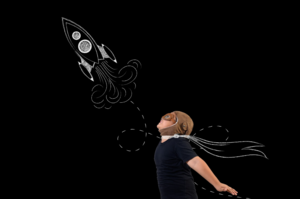How our eyes decouple from the environment during imagination
Part of our research deals with the phenomenon of "perceptual decoupling" of eye behavior during thought processes and imagination. We investigate how our gaze behavior deviates from the external visual world when we intensify our thoughts and internal imaginations. This 'decoupling' enables us to immerse ourselves deeply in our own thought worlds without being distracted by external visual stimuli. Findings from our eye-tracking studies are of great importance as they help us to understand how our brain protects the internal flow of thoughts from interruption. In addition, our research shows that gaze behavior is a powerful indicator of inward versus outward directed attention. The research is part of an FWF project P29801 (see EyeMag project page)
Further reading:
- Korda, Ž., Walcher, S., Körner, C., & Benedek, M. (2023). Effects of internally directed cognition on smooth pursuit eye movements: A systematic examination of perceptual decoupling. Attention, Perception, & Psychophysics, 85(4), 1159-1178. https://doi.org/10.3758/s13414-023-02688-3
- Korda, Ž., Walcher, So., Körner, C., & Benedek, M. (2024). Decoupling of the pupillary light response during internal attention: The modulating effect of luminance intensity. Acta Psychologica, 242, 104123. https://doi.org/10.1016/j.actpsy.2023.104123
- Walcher, S., Korda, Ž., Körner, C., & Benedek, M. (2023). The effects of type and workload of internal tasks on voluntary saccades in a target-distractor saccade task. Plos One, 18(8), e0290322. https://doi.org/10.1371/journal.pone.0290322


How our eyes follow our thoughts
Furthermore, we explore the fascinating phenomenon of the 'internal coupling' of gaze behavior to thoughts and ideas. Our research sheds light on how our eyes are vividly connected to our (creative) imagination. For example, we were able to show that we move our eyes very frequently when we solve a task in our head, but that people differ greatly in the extent of the coupled eye movements. These results and our ongoing studies allow us to gain insights into how our brain generates, navigates and changes mental representations and visual images. The research is part of the FWF project P34043 (see EyeMag project page).
Further reading:
- Annerer‐Walcher, S., Ceh, S. M., Putze, F., Kampen, M., Körner, C., & Benedek, M. (2021). How reliably do eye parameters indicate internal versus external attentional focus? Cognitive Science, 45(4), e12977. https://doi.org/10.1111/cogs.1297
- Ceh, S. M., Annerer-Walcher, S., Koschutnig, K., Körner, C., Fink, A., & Benedek, M. (2021). Neurophysiological indicators of internal attention: An fMRI–eye-tracking coregistration study. Cortex, 143, 29-46. https://doi.org/10.1016/j.cortex.2021.07.005